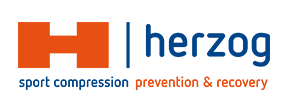The way of functioning of the Herzog Sport Compression Socks
The Herzog Sport Compression Socks have a beneficial effect in three ways before, during and after exercise;
Injury Preventive
During the foot landing in the walking movement, the socks ensure that there is much less lateral vibration and therefore less shaking load of the relatively heavy calf muscles. This creates less tensile forces on the tibia and Achilles tendons.
Useful in the Treatment
After strain (muscle tear) or cramping (microcrack) in the calf, the wound edges are tightly pressed and held together by the compressing sock, thus speeding up the healing process and reducing the risk of scarring. Scar tissue is still somewhat stretchy at best but will never regain the elasticity of the surrounding muscle. In addition, bruising is effectively prevented. The socks act as a suture patch which will cause the injury to heal more quickly.Shock absorbing
The calf remains compact and solid due to the compressing stocking, effectively reducing the shock during the foot landing. This shock-absorbing effect will reduce muscle damage. Less muscle damage also means that less fluid is retained in the space between the cells.Recovery – and Performance Enhancing
With intensive exertion and large shock load, muscle cell tissue will be broken down. Muscle cell residues bind water in the space between the cells, causing adverse effects on microcirculation. The supply of nutrients and oxygen to the muscle cell is impeded and the discharge of lactic acid (waste product of the incineration process) and carbon dioxide stagnates.
The socks offer relatively high compression at ankle level with a decreasing course towards the knee. Due to the increased pressure on the muscle tissue, the excess moisture, with dissolved waste from the combustion process, is forced back into the circulation from the inter-cell space. The so essential decreasing pressure of the stocking ensures that the vein blood, against gravity, is fed back to the heart adequately.
It is recommended to wear the socks for quite some time after exercise, in order to take full advantage of the restorative properties of the sock.
Mechanism of action, deepening for professionals
As described above, muscle damage from shock loading causes edema, fluid build-up, in the inter-cell space. So less muscle damage, due to the shock-absorbing effect of the Herzog socks, means that less moisture is bound with the dissolved waste slag from the combustion process. But how does that work?
The calf remains compact and solid due to the compressing stocking, effectively reducing the shock during the foot landing. As stated, this shock-dampening effect will reduce muscle damage.
Rehabilitation and performance enhancement
With large shock loads and prolonged exertion, muscle cell tissue (muscle protein) will be broken down. Muscle cell residues remain in the gap. A lot of protein in the intercellular space has a negative influence on the so-called Colloid Osmotic Pressure, which makes it more difficult for tissue fluid to be absorbed (absorbed) in the venous (venous) part of the capillary network As a result, moisture is retained, as it were bound in the insterstitium. Edema formation negatively affects blood circulation, which impedes the supply of nutrients and oxygen and stagnates the discharge of lactic acid (waste product of the incineration process) and carbon dioxide. The Herzog PRO Compression Socks offer a relatively high single-level compression of +/- 30mmHg, decreasing towards knee, +/- 23mm Hg. The effect of the socks in combination with the so-called calf muscle pump ensures, in particular, faster discharge of blood through the veins (fens). Due to the increased tissue pressure, the excess moisture, with dissolved waste slag from the combustion process dissolved therein, is forced back into the circulation from the intermediate cell space. The so essential decreasing pressure of the stocking ensures that the vein blood, against gravity, is fed back to the heart adequately.Sizing
As previously indicated, it is important that a decreasing pressure gradient from the ankle to the knee is incorporated into the compression sock. However, the combination of relatively high compression with this decreasing pressure gradient requires the precise measurement of the leg and foot. The shoe size alone does not give information about the shape of the leg. With the same shoe size there can be very different leg contours and there will be an important difference in effect of the pressure on the leg. In the case of a sock that is not properly measured, there may even be a counterproductive effect. Consider, for example, the difference in calf size between a sprinter and an endurance athlete when both may have the same shoe size. This is excluded when the legs are measured exactly.

